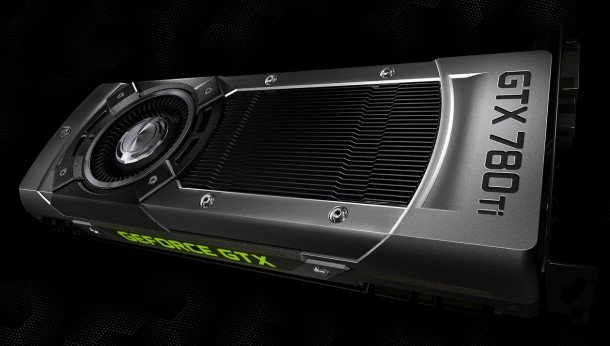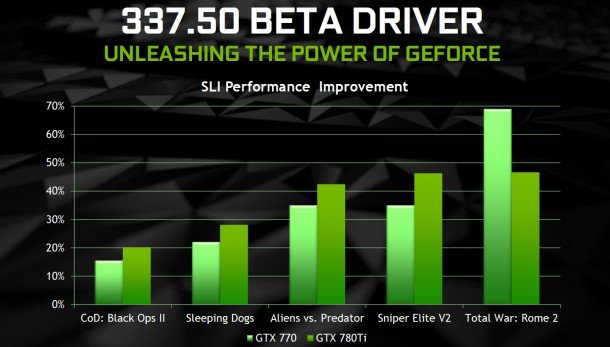Nvidia have gone a bit Mantle with their latest GeForce driver release

The green side of the graphics card divide are today releasing a new driver that aims to grab a little more gaming performance back for their GPUs. They're doing it in much the same way AMD's proprietary Mantle API is boosting things for the red team.
The new release, named 337.50, is available today, and has been designed to make the existing DirectX 11 API much more efficient for Nvidia graphics cards. They are doing this by reducing the CPU overhead that the driver and API generate, which in turn means you get all the performance your graphics card can muster without being hobbled by DirectX distracting your CPU.
I spoke to Ashu Rege, Nvidia's VP managing the Game Content and Technology division, about the new update a couple of weeks back at the GPU Technology Conference. “The goals are to reduce the overhead - which is the single biggest thing - where CPU cycles are used up in the driver rather than in the application.”
“We believe in improving efficiency of all industry-standard APIs, whether that's DirectX or OpenGL,” he said. “We want to keep improving them, there's no need to throw the baby out with the bathwater, as they say, no need to start from scratch. We already have pretty solid APIs, we just want to make them better.”
I've run some numbers and the performance boost is definitely tangible when you're running at 1920 x 1080 settings. Higher resolution gaming is still going to be heavily GPU-bound and so any CPU efficiency fixes aren't really going to generate any extra FPS fun.
Taking the synthetic StarSwarm benchmark as an example though I saw the frame rate on the latest DirectX 11 Nvidia driver go from an average of 52FPS up to 73FPS - that's a 40% performance boost with the GeForce GTX 780 Ti.
Compare that with the Radeon R9 290X using Mantle and that's offering some 62FPS on average. The huge amount of draw calls on StarSwarm were meant to really demonstrate how well Mantle functioned as an API, so it's quite telling that, with some CPU efficiency improvements to DirectX, Nvidia's driver can surpass AMD's dedicated Mantle tech.
Keep up to date with the most important stories and the best deals, as picked by the PC Gamer team.

Checking out the raw data from the StarSwarm tests does show AMD's API is still more able to offer a smoother experience. It's minimum frame rate for the Mantle benchmark was at 20FPS, while the GTX 780 Ti with the new driver could still only just about hit 13FPS.
It's a similar story with the recently-released Thief reboot. Running in Mantle sees the R9 290X hit 73FPS on average and 61FPS as a minimum at the highest settings at 1080p. With the previous gen driver the GTX 780 Ti was hitting 64FPS, but is now able to get close to the Mantle score at 71FPS. Again though the Nvidia card is lagging behind in terms of the minimum scores, notching up a low of 48FPS with the latest driver update.
All this improved CPU efficiency is very exciting for people running their cards at 1920 x 1080, but what about the high-res folk where the CPU isn't anywhere near being the bottleneck? There is a little hope in this update for them too, but only if they're rocking a multi-GPU setup to hit their high-res frame rates.

The new 337.50 driver has also been optimised for SLI with Nvidia showing some impressive performance boosts for it's GTX 770 and GTX 780 Ti in selected games. I haven't had a chance to check it out for myself yet, but the twin Titans in my main rig are going to be getting some serious benchmarking done on them very soon.

Dave has been gaming since the days of Zaxxon and Lady Bug on the Colecovision, and code books for the Commodore Vic 20 (Death Race 2000!). He built his first gaming PC at the tender age of 16, and finally finished bug-fixing the Cyrix-based system around a year later. When he dropped it out of the window. He first started writing for Official PlayStation Magazine and Xbox World many decades ago, then moved onto PC Format full-time, then PC Gamer, TechRadar, and T3 among others. Now he's back, writing about the nightmarish graphics card market, CPUs with more cores than sense, gaming laptops hotter than the sun, and SSDs more capacious than a Cybertruck.

